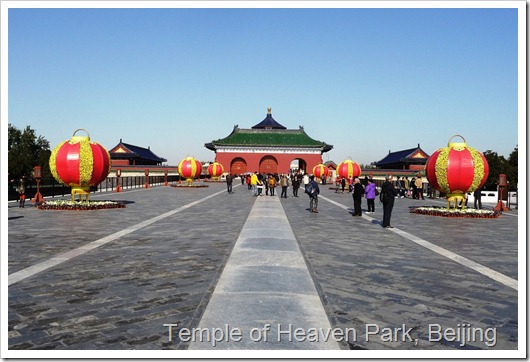The Temple of Heaven Park is my favourite place in Beijing, a peaceful refuge just a few kilometres south of the city centre. The Park is enormous, spread over 300 hectares and containing forests of cyprus and juniper, and some of the most beautiful buildings in the whole of China. Originally constructed in 1420, the Temple used to be a place where Ming and Qing dynasty emperors went to worship and pray for good rains and bumper harvests. These days it’s one of Beijing’s most visited cultural and recreational sites. Locals go there to stroll, exercise, play games and dance. Tourists flock there to enjoy the peaceful ambience and admire the beautiful buildings, top billing of which goes to the exquisite “Hall of Prayer for Good Harvests”. The Park has been listed on UNESCO’s world heritage register since 1998; amply deserved I think, unlike some of the more recent additions in other parts of the world.
Winter is knocking on Beijing’s door. There have already been a few chilly blasts, with lumps of hardened snow on the ground in shady places. But Monday was a little warmer, with a sunny blue sky and importantly, no wind. Perfect for a walk in the Park. But when the wind blows, it’s a different matter (Brrr!).
Meanwhile, a few kilometres to the north, the 18th National Congress of the Communist Party of China was underway in the Great Hall of the People on the western perimeter of Tiananmen Square. I took the subway there to check it out. Security was tight; the normal entrances to the Square were blocked and the crowds were instead marshalled and frisked through a couple of small bottlenecks. It took 20 minutes to get through, but the crush and wait were worth it. The Square was looking its best, decorated with enormous flower arrangements, and with many large red Chinese flags billowing in the late afternoon breeze. Not surprisingly, there was no chance of a peep inside the Great Hall of the People, much less the opportunity to nominate myself for a position on the Central Committee.
Travelling on the Beijing subway at peak hour is not something you would do twice if you could avoid it, so by 4pm I was already underground whizzing north back to my hotel before the crowds swarmed down the stairs and escalators to stretch the subway network to its limits. It’s a fantastic modern system, and for the commuter it surely must be the world’s least expensive. Beijing is an enormous city, but you can take a trip on the subway, no matter how far, for the princely sum of 2 RMB (about 30 Australian cents).
My hotel was in Haidian District near the Beihang University, around which are several cafes and restaurants serving excellent Chinese food. Memorable dishes included the beef, mushroom and bamboo hotpot, the stir-fried pork and peppers, and the chilli fish garnished with shallots and Sichuan peppercorns.
























